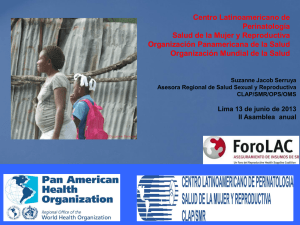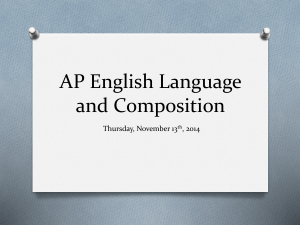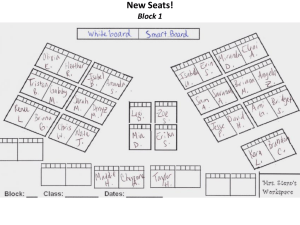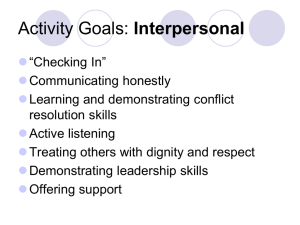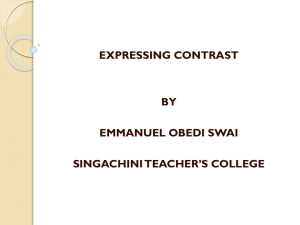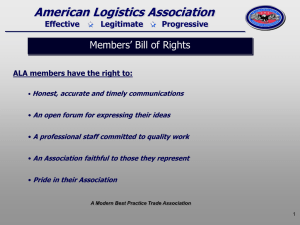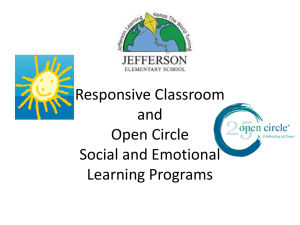Thematic Plannin Unit and Lesson Design 3 10.14.11
advertisement
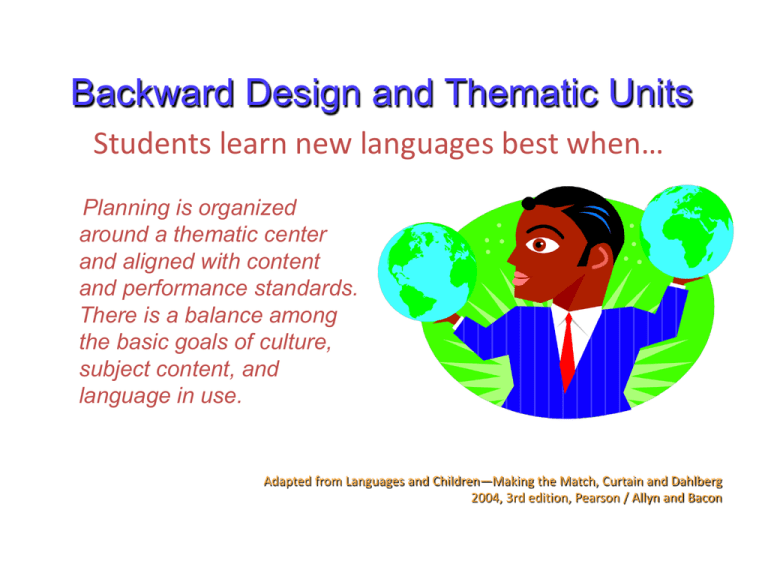
Backward Design and Thematic Units Students learn new languages best when… Planning is organized around a thematic center and aligned with content and performance standards. There is a balance among the basic goals of culture, subject content, and language in use. Adapted from Languages and Children—Making the Match, Curtain and Dahlberg 2004, 3rd edition, Pearson / Allyn and Bacon Teaching World Languages Unit Design Principles (UbD) (Socratic Circle) Thematic Planning (From Topic to Theme) Critique of Thematic Webs (Warm & Cool Feedback) Assessment (OPI; Integrated Performance Assessment; SOPA; Linguafolio) Lesson Planning (Components; Templates; Class Lesson Planning) Socratic Circle” Student-Centered Dialogue Socrates believed the answers to all human questions reside within us and that through disciplined conversation we can discover ultimate truth. “Socrates declared that he knew nothing, except the fact of his ignorance.” --Diogenes Laertius What is a Socratic Circle? A constructivist strategy in which participants engage in a conversation to collectively seek a deeper understanding of complex ideas. The Inner and Outer Circles Outer Circle Inner Circle Guiding Questions • Remember it is up to the group to make sure that everyone in the inner circle participates in the discussion. • The outer circle will listen, take notes on the conversation, and ask clarifying questions as needed. – How can you explain the “backward design” process? What are the stages? How do they relate to one another? – What are the key differences between traditional and UBD-aligned curriculum? How does it translate in the classroom? What are the obstacles to this transformation? – – Why are the tenets of Understanding by Design important for teachers and for their students? How do big ideas, enduring understandings, and essential questions relate to one another? Why are they important? – http://www.huffenglish.com/?p=363 Understanding by Design Step 3 (Middle) Plan lessons that will enable students to show you the results you want Step 1 (Start) Step 2 (End) Decide what you want students to know and be able to do at the end of the unit Determine how students will show you what they can do Understanding by Design Where do I find big ideas? • Concepts fairness food groups friend, ? • • Issues or Debates -perception vs. reality -poverty amidst plenty -majority always rules -? Themes -a balanced diet -man’s inhumanity to man -? • Problems or Challenges -The lure of fast food -How to spend within a budget -? • Theories -natural selection -big bang theory -? • Assumptions or Perspectives -art conveys meaning -terrorist vs. freedom fighter -? • • Processes -problem solving -research -decision making -? Paradoxes -fighting for peace -less is more -? Understanding by Design •Enduring Understandings Insights about big ideas that we want students to comprehend Understanding by Design From Big Ideas to Understandings about them • Understanding has 6 facets: – Explanation – Interpretation – Application – Perspective – Empathy – Self knowledge Understanding by Design Enduring Understandings Evoke Essential Questions These questions cannot be googled. They cannot be answered satisfactorily in a sentence. Understanding by Design Who is an American? Says who? What does it mean to lead a healthy life? What is wellness? “Is The Catcher in the Rye a comedy or a tragedy?” Understanding by Design Essential Question? What is the energy? Yes No Where in the world are we? Yes No Why travel? Yes No How is a Chinese family the same/different that mine? Yes No Yes No What’s in my suitcase? Understanding by Design Assess what we value, and value what we assess Move beyond "Teach, test, and hope for the best" Integrated Performance Assessment Performance Assessment in the Three Modes Interpretive Mode Tasks The Integrated Performance Assessment begins when students are asked to acquire information through an Interpretive mode task. Presentational mode Interpretive mode Interpersonal Mode Tasks Then, they react to that information by interacting with others. Presentational Mode Tasks Finally, they create a written or oral product that incorporates information acquired through the other two modes. Interpersonal mode Characteristics of Integrated Performance Assessment • • • • • Authentic Performance-Based Based on the 3 Modes of Communication Integrated Show developmental progress of proficiency: – • Novice (Novice-high; beginning) – • Intermediate (Intermediate-low/mid; emerging) – • Pre-Advanced (Intermediate-high; expanding) • Blend with classroom instruction and experiences Summative Performance Assessment • Title: • Theme: • Level: “Vive Sano” Health Novice – High • Overview: • You are preparing to go abroad to study in Spain. You are concerned about what you’ll be able to eat and what type of activities you will be able to do while you are there. In researching this information, you come across a public service announcement, or PSA, about healthy living. You watch the video to find out what “healthy living” means in Spain. While abroad you meet a fellow student and exchange information about what you do to stay healthy. When you return home, you develop a Spanish-language PSA for a local Hispanic radio station or newspaper as part of a community service project. Interpretive Mode In preparation for you trip, you research what “healthy living” means in Spain. You come across a video PSA called “Encesta por la salud” and you view it to gather information. Encesta por la salud http://www.youtube.com/watch?feature=player_detailpage&v=nCqn3NpjCjE Interpretive Comprehension Guide Watch the video “Encesta por la salud” and complete the following exercises. The video and exercises are divided into 7 sections. You can listen to each part more than once. Parte 1. Salud, amigos The speakers mention that we are all different in many ways and they provide examples of these differences. List the differences in English (6 answers): 1. _________________ 4. _________________ 2. _________________ 5. _________________ 3. _________________ 6. _________________ According to the video, do these differences matter? Why? What is bad for our bodies? Why? The speakers mention how the previous answer is also bad for other things. What are they? (circle all that apply) Brain Jumping Heart Skating Shooting hoops Thinking Running Swimming Sleeping Flying Breathing Resting •2. •6. Parte 2. El valor del desayuno A. According to the video, why is a good breakfast so important? B. What are three consequences (mentioned in the video) of not having a good breakfast? C. A few healthy sample breakfast foods are mentioned, what are they? (circle all that apply) Parte 3. Fruta y verdura: di que sí We should eat fruit and vegetables that vary in ___________________________. While one of the basketball players eats a banana, he says “a vuestra salud.” What does that mean? We see the speakers eat a number of fruits and vegetables in this section of the video. Circle them in the list provided (in Spanish - there are 6 of them). Lechuga Zanahoria Fresa Melón Uvas Manzana Espárrago Plátano Naranja Pera Apio Espinaca Conclusión: A. If you were given new title choices for each section, which would you choose? 1. Salud, amigos a. Cuantos más kilos mejor b. Todos debemos ser iguales c. Vive sano, evita el sobrepeso 2. El valor del desayuno a. No comas desayuno a diario, puedes engordar b. Consume un desayuno saludable todos los días c. Lo importante es comer desayuno, lo que comes no importa 3. Fruta y verdura: di que sí a. La comida en colores b. Come verde c. Los colores del arco iris B.In your opinion, what is the message of the “Encesta por la salud” campaign? Is this the same message you would hear in the U.S.? Why or why not? Conclusión: A. If you were given new title choices for each section, which would you choose? 1. Salud, amigos a. Cuantos más kilos mejor b. Todos debemos ser iguales c. Vive sano, evita el sobrepeso 2. El valor del desayuno a. No comas desayuno a diario, puedes engordar b. Consume un desayuno saludable todos los días c. Lo importante es comer desayuno, lo que comes no importa 3. Fruta y verdura: di que sí a. La comida en colores b. Come verde c. Los colores del arco iris B. In your opinion, what is the message of the “Encesta por la salud” campaign? Is this the same message you would hear in the U.S.? Why or why not? Interpersonal Mode • While abroad you meet a fellow student and exchange information about what you do to stay healthy. In your conversation, be sure to: – – – – – Note the foods you eat and foods you avoid to stay healthy. Mention the activities that help you stay healthy. Compare each other’s daily routines and other habits. Discuss healthy hygiene habits. Identify which of your own habits you would like to improve. Characteristics of Novice-High Speakers • Respond to simple, direct questions or requests for information; express personal ideas by relying heavily on learned phrases or recombination of these; provide short and sometimes incomplete sentences in the present tense and may be hesitant and inaccurate • Able to ask a few formulaic questions • May appear surprisingly fluent and accurate when using learned material • Handle simple survival tasks at the Intermediate level, can sometimes respond in sentences, but cannot sustain this level of discourse Presentational Mode • As part of your community service project, you develop a Spanishlanguage public service announcement (PSA) about ways to stay healthy, using the “Encesta por la salud” video as a guide. Remember to tell your audience (name audience here) things they should and should not do to stay healthy. You can either record your message or write it. – – – – You must include information about the following three topics: Nutrition Exercise/Being active Hygiene Student Self-Assessment http://www.ncssfl.org/links/index.php?linguafolio I can do this easily and well. I am able to introduce myself to someone. I can understand basic information such as months of the year and numbers, especially when there are pictures or other clues to help me. I can understand the difference between a question and a statement. I can follow some simple directions, especially when people speak slowly and use gestures. I can understand if you tell me a story or song. I can tell someone about the things I like and do not like. I can do this sometimes. I need to work on this. Student Oral Proficiency Assessment http://www.cal.org The SOPA interview is a language proficiency assessment instrument designed to allow young students to demonstrate their highest level of performance in oral fluency, grammar, vocabulary, and listening comprehension. Thematic Unit Planning Galapágos http://senoraglass.com/ • Natural way to “chunk” curriculum • Provides a thematic focus for students: continuity and connections, across concepts and languages • Allows for an authentic, literature-based focus • Makes content PERSONALLY relevant Topics vs. Concept-based Themes TOPICS THEMES • • • • • • • • • • • Who am I at home and at school? • Living things are all around me • We are similar to and different from Mexico • What makes me who I am? • What makes a house a home? • My place in the world • Why do people move? Colors and Fruits Weather Body parts Pets Shapes Things in my classroom Myself Family Community Population Now It’s Your Turn TOPICS • • • • • • • • • • • • Colors and Fruits Weather Body parts Pets Shapes Things in my classroom Population Friends Clothing Directions Time Numbers THEMES Sing a Song (Parents and me) Drawing (Giant Panda) Theme Unit Overview Chanting Story Chanting and Play Rubber String Children’s Social Activities Handkerchief Game and Song Children’s Trick Children’s Collection (vocablulary) (Reading, Speaking, Listening, Writing) Read excerpts from The Ceremony of the Panther by Luke Wallin, a young adult novel that explores themes of conservation. Retrieved from lukewallin.com/anovels.ht m. Discuss the central ideas. Write a short story using one of the ideas. (Writing) Have students draw and illustrate posters to hang around the school that promote themes of good environmental citizenship. Logical Mathematical Linguistic Spatial (Reading, Writing, Listening, Speaking) Create a chart that shows the increases in global warming during the last century. Explore the technological breakthroughs associated with various increases (discovery of electricity, the advent of the automobile, etc.) and simple statistics. Ways we can help protect the environment (Speaking, Reading, Writing) Plan a community garden on the school grounds. Research plants to grow. Design a plan for planting and maintaining the garden in shifts of student teams. Organize students to give tours to parents, staff and students. Bodily Kinesthetic Naturalist Musical Intrapersonal (Listening, Reading, Speaking) Watch a video and learn a song that teaches language and content such as “The Three R’s: Reduce, Reuse, Recycle.” Retrieved from http://www.youtube.com/watc h?v=wtoeZ9Nkeqk&feature=r elated (Writing) Take the class on a field trip to a park and have students choose one natural element (the wind, a tree, etc.) to write a poem about in their journals. Interpersonal (Listening, Speaking, Reading, Writing) Design a communicative task which requires pairs to brainstorm ways to verbally encourage polluters to change their ways. One student role plays the bad behavior and the other student will suggest better behavior. Together, as a class, summarize the language in a chart. (Listening, Speaking, Writing) Bring in different leaves and branches and categorize them into “deciduous” and “conifer.” Talk about how different trees are affected by polution and how you can tell. Discuss solutions. Write letters to local politicians to encourage them to strengthen legislation. Understanding by Design Stage 3: Plan Learning Experiences and Instruction Understanding by Design was the most DESIGN well-designed WHATWhat IS EXEMPLARY FORlearning LEARNING? experience you have ever encountered as a learner? Consider experiences both in and out of school. What features of the design-NOT THE TEACHER’S STYLE-made the learning engaging and effective? Describe the design. Understanding by Design Share your recollections and analyses with your small group. Make a list of the important “take-aways.” What do well-designed learning experiences have in common? What must be built in by design for any learning experience to be effective and engaging for students? Comparison: American holidays and Indian holidays Connections: Geography Currency conversion Communication: 1)Engage in simple conversation 2) Recognize basic vocabulary 3) Present basic information Community: Email to students in India Simple conversation with Hindi teachers A trip to India Culture: Holidays and festivals Social behaviors and gestures Talk about Holi, Diwali, Rakhi, Id Xmas State passport number, nationality and name for airport customs Communication: 1)Engage in simple conversation 2)Recognize basic vocabulary 3)Present basic information Use the calendar and the map to discuss the trip Describe weather in India Describe clothing for trip ( the body) Convert money from dollars to rupees Talk about likes and dislikes in food and Indian cities Greet, introduce themselves and say goodbye Language Functions: How We Use Language for Communication Socializing Getting Things Done Organizing and Maintaining Communication • Using different modes of address • Inquiring about health • Greeting/introducing/t hanking • Requesting/suggesting /making arrangements • Reacting to offers, suggestions, requests, invitations • Instructing • Inviting • Attracting attention • Expressing lack of comprehensions • Asking for repetition or rephrasing • Asking how to say something in the target language • Asking how to spell a word in the target language • Asking someone to explain what they just said Language Functions: How We Use Language for Communication Exchanging Information • Identifying • Describing • Asking for/giving information • Narrating • Inquiring about or expressing knowledge/opinions/wishes • Stating needs • Inquiring about/stating preferences Expressing Attitudes • Expressing admiration • Expressing approval/disapproval • Expressing interest/disinterest • Expressing regret/apology • Expressing need Action Verbs for Unit/Lesson Planning Bloom’s Revised Taxonomy Bloom’s Revised Taxonomy Knowing acquire define identify label list match name outline recall recognize select state Understanding change classify conclude convert demonstrate determine differentiate distinguish draw estimate explain extend extrapolate fill in give in own words illustrate infer initiate interpret make predict prepare read rearrange re-order rephrase represent restate summarize transform translate Applying apply change choose classify develop discover employ generalize modify organize relate restructure show solve transfer use Analyzing Evaluating Creating analyze categorize compare contrast deduce derive detect diagram differentiate discriminate illustrate recognize select translate appraise argue assess compare consider contrast criticize decide judge justify standardize validate classify combine compose construct derive design devise formulate modify organize originate produce propose relate revise specify transmit Action Verbs for Unit/Lesson Planning Bloom’s Revised Taxonomy Skills adjust assemble build construct demonstrate develop draw follow manipulate operate participate perform play practice speak use Personal/Affective Receiving accept ask choose identify listen locate name select reply respond use Responding answer approve assist attempt commend comply conform discuss label participate report spend leisure tell volunteer Valuing assist maintain challenge offer compare persist complete praise decide prefer defend express differentiate propose dispute react form regulate help respond join seek out justify select share show support Organization abstract alter arrange balance combine criticize defend formulate integrate modify order organize prepare question relate Characterization act avoid change display manage perform propose require resist resolve revise solve use verify Goals and Objectives Ambiguous Clear • Learn greetings and leave takings • Know • Understand • Greet others using formal and informal expressions • Identify and describe family members • Be familiar with • Have a grasp of • Have an awareness of • Invite a friend to do something with you after school • Refuse and invitation from a friend and tell why • Be conversant with • Be aware of • Locate the Spanish speaking countries on a map of Latin America • Compare the school schedules of an American and French middle school student Lesson Plan Unit ________________________ Grade Level ________________ Lesson Number _______ of _________ Time of Year to be Taught___________ Stage 1: What will students know and be able to do at the end of this lesson? DO KNOW Stage 2: How will you know that students can do that? Stage 3: What instructional activities will be used? Opening/Activity 1: (Hook) How will the teacher engage students? Activity 2: Providing Input Activity 3: Guided Participation Activity 4: Individual/Small Group Participation Closing/Activity 5: Summarization/Reflection/Application of Learning Materials Needed for this lesson Paradigm Shift In Instructional Planning Source: Shrum & Glisan, 2000 Adapted from Bragger & Rice, 1998 Old Paradigm New Paradigm Content/Culture Stated in terms of grammatical knowledge Stated in terms of what learners should know and be able to do with the language Skills Bits and pieces of cultural Interdisciplinary and cultural information; few, if any, connections connections; integration of to other disciplines cultural and academic content The Learner Practice of individual skills: listening, speaking, reading, writing Integrated practice of skills: modes of communication The Teacher The center of instruction Facilitates instruction and guides student learning; plans for cooperative learning experiences Materials Textbook as primary resource Textbook as one of many tools that include authentic documents, myths, fairy tales, story books, videos, music, etc. Assessment To evaluate student achievement; focus on discrete skills; primarily pencil & paper To assess progress in meeting standards; completion of realworld tasks

